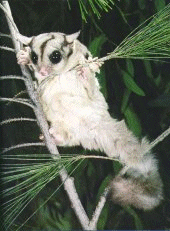 Bandicoot
Bandicoot
Bandicoots, on the whole, are mixed feeders; that is, they eat insects, vegetable matter of many kinds, and sometimes very small mammals and lizards. The food preferences vary considerably from one genus to another, some groups being entirely insectivorous, others vegetarian, and some accepting a mixed diet. These varied feeding habits are reflected in certain main characteristics by which bandicoots are classified: their teeth consist of many incisors, typical of the marsupial carnivores (flesh-eating), but have the hind-foot combined toe structure of the herbivorous (plant-eating) kangaroos.
There are two main evolutionary lines of bandicoots. One comprises the coarse, almost spiny-furred ordinary bandicoot and the Pig-footed Bandicoot; the other is represented by the softly silken-furred, long-eared rabbit bandicoots. A number of species dig burrows, while others nest under dense vegetation or among logs or boulders.
The pouch opens in a rearward direction on all bandicoots. Some members of this family have become very rare, possibly extinct, while many have become uncommon and even those that were abundant have suffered great loss of numbers. They are useful little animals, even when they dig in gardens, because they consume a great quantity of harmful insect larvae (eggs).